What to know about group communication
Group communication takes place each time three or more people engage in a conversation verbally or in writing. In terms of group communication in a business setting, the term refers to communication between a group of a minimum of three professionals with a common goal of sharing ideas and information, collaborating on a project, resolving issues, or negotiating a deal.
Effective group communication in this regard, is essential to achieving virtually any business goal.
To help organizations better understand the group dynamics and improve their group communication, in this blog post, we:
- Define group communication,
- List out the advantages and disadvantages of group communication, and
- Offer tips on how to improve group communication.
So, let’s dive in.

What is group communication?
According to the Oxford Dictionary of Media and Communication, group communication is defined as “The process by which verbal and nonverbal messages are exchanged between a limited number of people, usually from 3 to about 20, the upper limit being determined by the extent to which each member can interact with every other member with the potential for mutual influence. Traditionally, this refers to interpersonal communication between group members in face-to-face interaction.”
Essentially, group communication refers to any verbal or nonverbal interaction between a group of 3 to about 20 people. Size plays an important role in categorizing a communication situation as group communication because it determines the ability of each member to interact with every other participant in the conversation and be mutually influenced. A group of 20 or fewer participants is commonly referred to as the small group, whereas communication between 2 individuals is characterized as interpersonal communication.
What are the main features of group communication?
To get a better understanding of group communication, let’s get a closer look at all the features of group communication that affect its outcome and define it more closely.
In a broader sense, group communication consists of the 6 main features:
- Participants — senders and receivers of the messages.
- Message — the piece of information communicated across a group.
- Noise — any external element that affects the original message and how it is interpreted and perceived. Anything from environmental noise and ambiguous body language, to cultural barriers and lesser-known jargon, can fall into this category.
- Context — external circumstances and conditions in which the communication takes place that largely determine how the message is interpreted. Some of the factors that make up the context in group communication are:
- the situation,
- culture,
- environment,
- time,
- place, and
- roles of the participants.
- Channel(s) — the medium used to conduct the communication (business chat app, email, phone, etc.).
- Feedback — the response made by the receiver(s) of the message.
When it comes to more specific features that characterize group communication, there are five more aspects that factor in. In the book titled “Small Group Communication” Jasmine R. Linabary, Ph.D. defines five more features that factor into group communication.
- Size — the number of participants in group communication.
- Structure — in a business setting, the structure of group communication is determined by the size of the group, the tasks and resources, and the roles and characteristics of group members.
- Reachability — a factor in the group structure that demonstrates the extent to which one group member is or isn’t connected to other members.
- Interdependence — participants in group communication have the same purpose and the same fate.
- Shared identity — group members are connected via a common mission and vision.
Internal structures in group communication
The previous chapter defines structure in group communication in a general sense. More specifically, group communication is largely affected by internal group structure. Rather than previously mentioned external factors, the internal structure is defined within the team’s or organizational hierarchy and it largely determines the nature and the outcome of group communication.
Essentially, there are two main internal structure types in group communication:
Centralized — Refers to groups that have a central figure (authority) that guides the conversation.
Decentralized — This structure allows equal stakes to all participants in group communication, without a leader facilitating the conversation in a group.
Most commonly, a centralized structure works better for communicating urgent tasks, whereas a decentralized structure is more appropriate for communicating more complex tasks that don’t require immediate action, according to the research found in “Small Group Decision Making” by Donald G. Ellis and B. Aubrey Fisher.
Group communication channels
There are many different forms or channels group communication can take place in.
The most common group communication channels include:
👩💼👨💼 Formal in-person team meetings — A group of coworkers or a team gather in an office or other formal setting to discuss project progress, future objectives, or current issues. Usually, these types of interactions are guided by a leader figure, such as a manager.
🕺🏿💃🏾 Informal in-person group gatherings — Although commonly connected to social groups outside the workplace, informal gatherings also take place with groups from the same organization. Company parties, wellness retreats, or team-building events are some examples of in-person group communication between groups belonging to the same organization.
📧 Group emails — A form of written group communication most commonly used for formal exchange between groups working on shared projects. Group emails may not be the most effective solution, especially in urgent situations that require a fast exchange and quick access to critical information.
☎️ Conference calls — Conference calls allow the immediacy of in-person meetings, with the added benefit of allowing participants to join from anywhere. Usually conducted via video conference tools, conference meetings are commonly guided by a central, leader figure.
📲 Group message chats — Team members or groups working on a shared project use business messaging apps to share progress updates, chit chat, discuss ideas, and share files with team members or external stakeholders.
📝 Memos — Or memorandums follow a more formal communication form between groups. Memos are used to communicate important updates, tasks, and policy changes usually across the organization, but can also be used to communicate group-specific information.
🗒️ Project management task lists — A group working on a shared project uses project management tools to display, track, and communicate deadlines, status updates, as well as further discussions.
Group communication examples
Now that we’ve offered an outline of the theoretical framework for group communication, it’s time we take a closer look at how it takes place in actual business situations.
🔸 Group communication in a group message chat
A marketing team manager starts a discussion with their team members about the upcoming social media campaign. They are using a dedicated channel in a business messaging app to have a quick chat across the team. Team members join the conversation by listing out their completed and assigned tasks. Several team members respond to each other’s messages in threads when they want to elaborate on the specific point and add additional information. They also respond using emojis to acknowledge the author of the message and express their approval, agreement, or excitement.
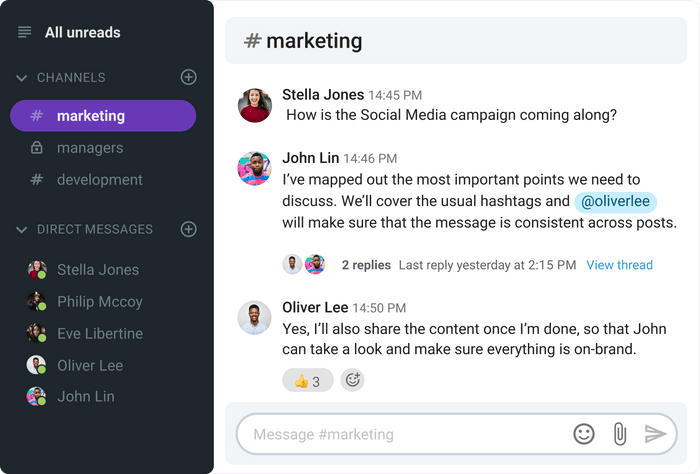
🔸 Group communication across project management task lists
A marketing team working on a client project uses a project management tool to communicate task lists. Tasks are categorized by days and include deadline, status, and assignee names. The team uses a message box located next to each task name for additional conversations between the assignee and the project manager.
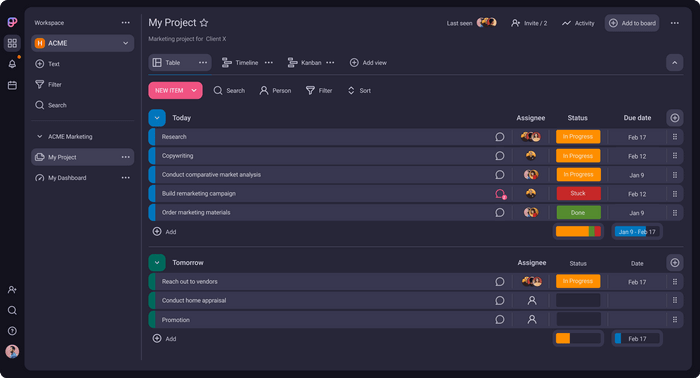 An example of project task lists
An example of project task lists
What is the importance of group communication?
The importance of group communication, especially in a business environment is multifold. In addition to facilitating teamwork and collaboration, group communication is also integral to the social aspect of team interaction. Moreover, messages exchanged within group communication facilitate decision-making and conflict management. Group communication essentially determines the entire dynamic of the group as well as the overall project success.
What are the advantages and disadvantages of group communication?
In theory, group communication generates plenty of benefits to organizations in terms of facilitating collaboration and creating opportunities for team bonding. However, we’ve all witnessed at least one instance of group communication gone wrong whether due to external factors like physical barriers, or due to interpersonal team dynamics. Although benefits outweigh disadvantages when it comes to group communication, it’s still important to consider both when looking for opportunities for improvement.
Let’s take a closer look at all the major advantages and disadvantages of group communication to learn how to best utilize the benefits and improve on drawbacks.
Advantages of group communication
From improving collaboration to creating tighter relationships across an organization, group communication is a key factor facilitating virtually any process within an organization.
Let’s go over a list of advantages of group communication for a more detailed insight.
- 🪟 Better transparency and clarity among group members about goals and expectations — Group members that frequently communicate are more likely to establish trust and transparency among themselves. Effective group communication — when practiced regularly — offers plenty of opportunities to share regular updates across teams and foster transparent communication. In addition to allowing more clarity about goals and expectations, transparent communication helps develop a favorable organizational reputation with employees and beyond, one study finds.
- 🧑🤝🧑 Improved teamwork and collaboration — Effective team communication is one of the key facilitators of successful collaboration. In fact, teams that communicate constructively experience more productive collaboration and suffer fewer mistakes, research finds.
- 📈 Increased productivity — It’s no secret that effective group communication between team members drives productivity and ensures better results. According to a McKinsey report, teams that communicate more, experience a productivity increase of up to 25%.
- ✔️ More effective decision-making — Decision-making largely depends on effective team communication, as business communication literature suggests. Multiple perspectives present in effective group communication contribute to better objectivity and accuracy when making decisions within teams. Moreover, asynchronous communication powered by team communication tools seems to perfectly align with the new work models and their communication dynamics.
- 🤝 Closer relationships and improved trust between team members — Effective communication between team members facilitates trust within an organization, according to a study published in the International Journal of Business Communication. Quality, quantity, and adequacy of information play an important role in establishing trust — the study suggests. In addition, open, frequent, and respectful communication is a key driver of relationship building between team members.
Disadvantages of group communication
While group communication provides plenty of benefits, there are specific challenges and barriers to be mindful of when working towards improving group communication.
Physical barriers — When group members don’t occupy the same physical space, it can pose a potential challenge to group communication. Moreover, inadequate communication tools, poor internet or phone connections can also hinder communication quality.
Perceptual barriers — Personality types and the general outlook on life of the group members play an important role in how each individual group member will perceive the work tasks and messages in group communication.
Emotional barriers — The current emotional state of the participants in the group communication affects how they will formulate and interpret messages. An individual going through a rough time can change the group communication dynamic.
Interpersonal barriers — Group communication is also largely affected by how individual group members perceive themselves. Overly confident individuals will interact in a completely different manner than group members who are more insecure.
Cultural barriers — Assumptions, stereotypes, and nonverbal misinterpretations are some of the most common obstacles to successful intercultural communication, as identified by LaRay M. Barna. As the number of international teams increases, organizations need to put more emphasis on overcoming these barriers to perfect cross-cultural communication across their teams.
Language barriers — Although formally considered as a cultural barrier, language barriers in group communication can occur even when all members speak the same language. Specific technical terminology, or industry jargon can also cause misunderstandings.
💡 Pumble Pro Tip
For a more in-depth analysis of communication barriers, be sure to check out our ultimate guide:
- The barriers to effective communication
Tips for improving group communication
Successful team collaboration relies on each member having strong group communication skills. Otherwise, your team communication may give way to misunderstandings and conflicts which can decrease overall productivity and cause unnecessary delays. To avoid this scenario, consider adopting the following tips to promote effective group communication and help your teams collaborate better.
Assess communication styles of group members
One of the greatest challenges of group communication is that there is no universal style of communication each individual participant will use. Diversity, in this regard, is both a gift and a curse. However, taking the time to assess and understand where your team members come from when it comes to communication styles will go a long way in improving your group communication.
Some of the most common ways you can review your group members’ communication styles are by using personality tests like the Myers-Briggs Type Indicator (MBTI) or the DiSC assessment. While the Myers-Briggs Type Indicator offers sixteen personality types defined by four different scales, the DiSC assessment distinguishes four main behavioral styles that can be applied to communication.
- Dominant: Usually described as confident, results-oriented, and placing emphasis on achieving business goals, dominant communicators may also appear blunt.
- Influencer: People with i personalities tend to show a great amount of enthusiasm and optimism, especially towards teamwork and collaboration. Influencer communicators thrive in relationship building and persuading others.
- Steady: Calm and sincere, steady communicators value cooperation.
- Conscientious: Individuals belonging to the C personality profile most often focus on quality, accuracy, and expertise. They are detail-oriented and prefer working on their own.
Consider assessing your workplace groups by their communication styles to better understand how different individuals like to communicate and identify shared traits you can center your group communication improvement around.
Offer support and effective communication training
Once you’ve done the groundwork of assessing your group’s communication styles, you’ll understand that not all members are as skilled communicators as you might think. Moreover, you’ll notice differences in styles and preferences among members of your team.
Of course, to strive for uniformity in group communication would be unreasonable. However, there are ways to improve group communication in your team by making the most out of each member’s potential.
Courses, workshops, and communication training tailored to target specific group communication challenges are all great ways to refine individual communication skills and thus improve communication in a group. Depending on the specific group communication challenges you identify in your group dynamic, you can also design workshops that target specific communication elements, such as collaboration, negotiation, or public speaking. Moreover, group communication training can address specific channels of communication such as writing effective announcements in your company team chat, for example.
Whatever the case, providing your team members with proper tools and techniques will improve how they communicate within a group and increase their overall job performance.
Embrace transparent communication
Transparency and openness in workplace groups not only facilitate more efficient group communication and collaboration, but it fosters mutual trust, supports innovation, and — as one TINYpulse survey shows — directly affects employee satisfaction.
Conversely, a lack of transparency brings about severe challenges that damage productivity and teamwork. Without clear transparency guidelines and incentives in place, teams may resort to the pesky silo mentality, gossip, and micromanagement, all of which stand in the way of productivity and positive workplace culture.
On the other hand, when team members feel heard and valued in a transparent workplace environment, they are more likely to increase their engagement and productivity. Group communication thus improves as each individual feels empowered to participate and express their point of view.
To promote transparency in group communication, consider the following steps:
- Encourage vulnerability to develop trust — Create a culture of authenticity where people feel comfortable sharing transparently.
- Share real-time updates — To keep everyone in the loop, consider creating a practice of providing timely updates on all major tasks and projects.
- Give reasons for withholding specific information — Don’t leave room for assumptions, explain specific confidentiality restrictions.
- Encourage empathy with respect for privacy — Create a balance between showing empathy for people’s issues and invading their privacy.
- Use simple vocabulary — Promote simplicity in group communication and discourage the use of industry jargon to avoid alienating people from different departments or with different experience levels.
- Create direct communication channels with tools — Use business messaging tools that allow instant communication and feedback.
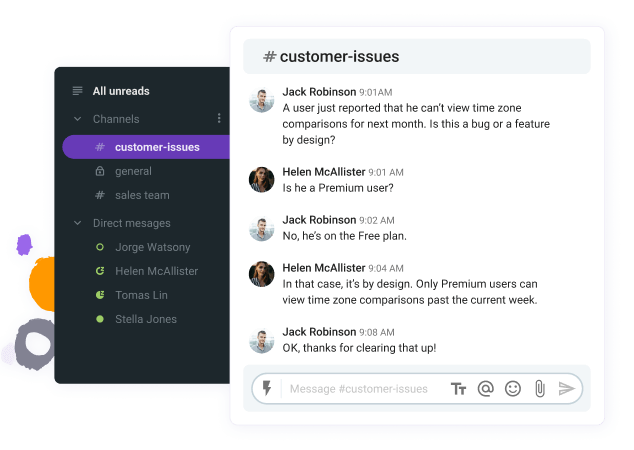 An example of instant communication in Pumble (business messaging app)
An example of instant communication in Pumble (business messaging app)
💡 Pumble Pro Tip
To get more in-depth insight into the principle of open communication at the workplace, be sure to visit our guide on the blog:
- Transparent communication: why and how to embrace it at work
Utilize the right communication channels
Group communication takes place in several different forms via different communication channels. It’s paramount for employees to have a clear understanding of which communication channels to use for different types of group exchange. Without a clearly defined set of tools, workplace groups may experience challenges such as miscommunication and misunderstandings which damage group efficiency.
Depending on the work model, the line of business your organization operates in, or team preferences, you will default to using specific group communication channels exclusively or more frequently than others.
However, there is another important element to consider when establishing official communication channels, and it has to do with generational inclusivity.
We reached out to Mark Beal, Assistant Professor of Professional Practice, Communication at Rutgers University School of Communication and Information, and asked to hear his perspective. Professor Beal highlights the importance of communication channels in improving group communication. He suggests generational inclusivity and communication channels are two key, interdependent features of effective group communication.

“There are two key elements to successful group communications in business today – inclusivity and the channels of communication. Today’s workplace includes executives across four generations – Gen Z, millennials, Gen X, and boomers. From junior to senior executives, all need to be included and genuinely feel like they belong in the conversation and can actively participate for effective communication. Related to that are the channels of communication. As new communication channels such as Pumble, Teams, and even text are complementing traditional email communication, all members of the group have to feel comfortable with utilizing emerging channels or they will not participate and not feel like they belong. Inclusivity, belonging and a comfort level with emerging channels will result in more effective group communication as business continues to evolve and transform.”
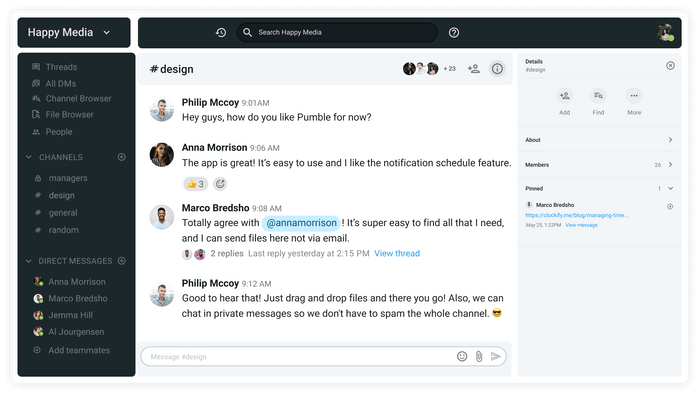 Pumble as a communication channel
Pumble as a communication channel
Define individual roles
Clear roles in teams allow for smooth collaboration and successful communication between group members. Having their daily and monthly tasks and responsibilities clearly outlined helps team members understand their roles better. At the same time, clearly defined responsibilities allow employees to get a better insight into group hierarchy. When each member of the group has a clear understanding of their roles and responsibilities, group communication becomes more structured and constructive.
Avoiding to establish individual roles can lead to a number of potential group communication challenges. For example, when team members don’t have a clear understanding of what is expected of them in terms of behavior, they might unintentionally break the code of conduct and overshare, or engage in inappropriate behavior such as gossip.
To avoid misunderstandings, conflict, and miscommunication in your teams, consider assigning each team member a clear set of responsibilities and expectations. That way, you can eliminate any potential ambiguity and improve overall group communication.
💡 Pumble Pro Tip
To learn more about setting, managing, and communicating expectations, check out our guide on the blog:
- How to manage and communicate expectations as a manager clearly
Foster collaboration
In a group setting, no task or project is done in a vacuum, or individually. Any project or task’s success is a result of a group effort. Even if you’re managing a content writing team, where each writer works on a separate blog post, they still require some team and editor feedback to ensure maximum quality of their piece. This form of collaborative culture, once established, reflects in group communication.
Group members that have developed a team-centric mindset understand the importance of effective and respectful communication in team collaboration, conflict resolution, and negotiation.
To establish a sense of teamwork, and ensure each individual member communicates with the group’s/project’s best interest at heart, organizations can consider allowing more opportunities for team bonding through informal conversations. If your team operates on-site, provide a place for weekly team gatherings where people can chat and bond over shared interests.
For remote teams, consider creating dedicated channels in your business messaging app where your team members can have regular communication and get to know each other better. That way, you’re letting your team build meaningful relationships that translate into how they communicate during teamwork.
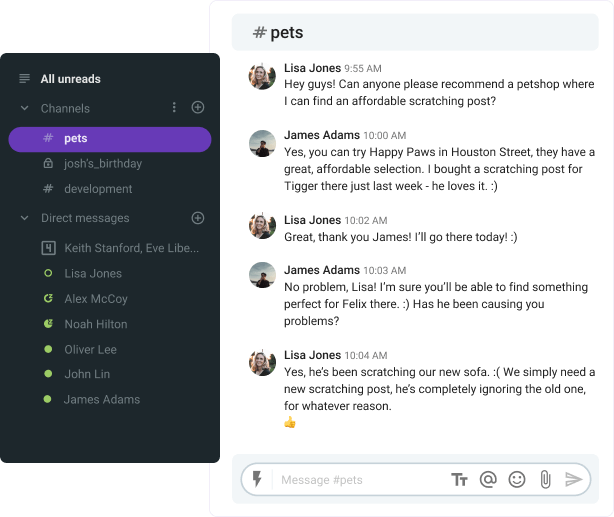 Informal chat in Pumble (business messaging app)
Informal chat in Pumble (business messaging app)
💡 Pumble Pro Tip
For an extensive list of steps towards better collaboration, visit our ultimate guide:
- Fostering teamwork and collaboration through 4 stages of group development
Lead by example
Group communication, at the end of the day, is only as effective as leadership communication.
Essentially, your team will consciously or subconsciously look up to you and mirror your communication style. It’s up to you to make this more of a conscious choice and role-model the behavior and communication you want to see practiced in group communication in your team.
When looking to role-model effective communication to a group, managers should consider applying some of the most important leadership communication skills that translate into better group communication. In addition to being assertive in their communication with the team and willing to own up to their mistakes, leaders can consider building on:
- Confidence
- Transparency
- Active listening
- Kindness, and
- Empathy and perspective.
💡 Pumble Pro Tip
To further explore leadership communication and learn how it affects teams, be sure to check out our guide on the blog:
- Skills, strategies, and tips for improving leadership communication
Wrapping up: Effective group communication is the basis for productive teamwork
Poor group communication affects virtually every member and process in an organization. In addition to breeding conflicts and misunderstandings, ineffective group communication also slows down overall productivity and engagement. Taking necessary steps to improve group communication, thus, creates immediate enhancements to teamwork, productivity, and relationships between employees. Use the tips provided in this article to improve group communication and create a positive workplace culture in your organization.






